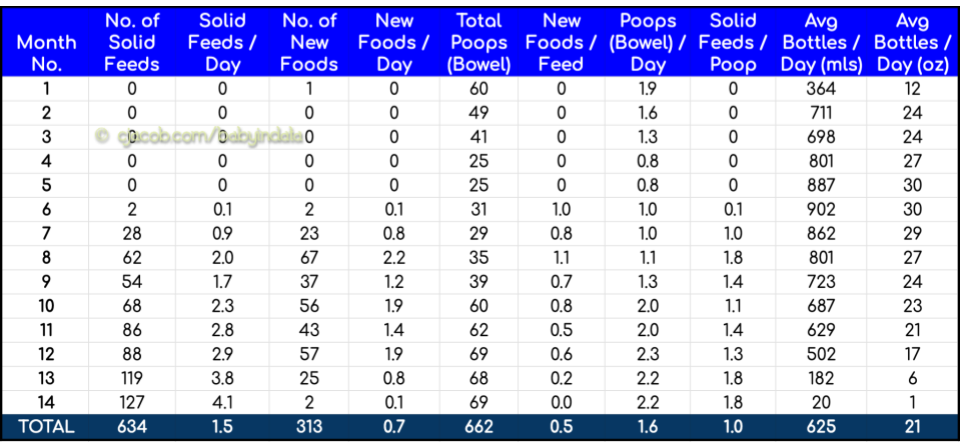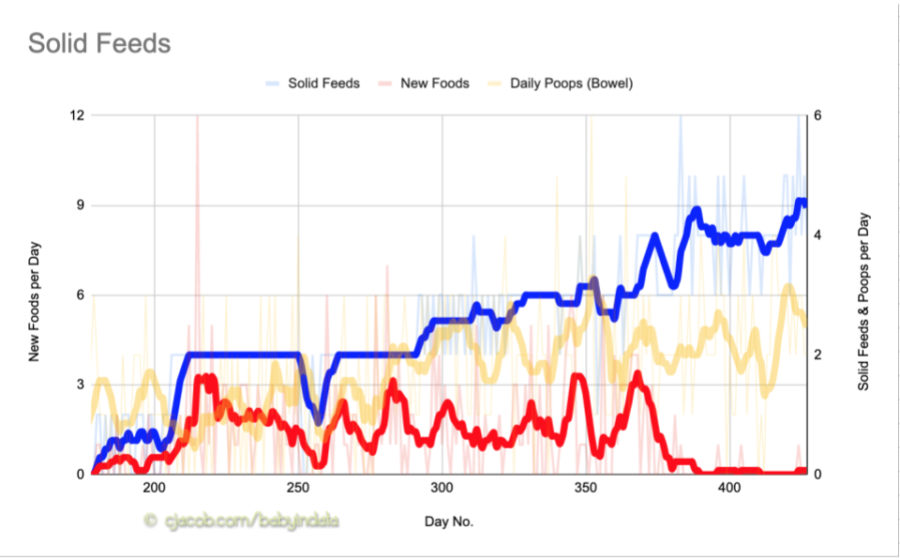So this can be yet another controversial and deeply personal topic for parents as it relates to their baby: introducing solids. I am sure there are things I will say or show here through data with which people will vehemently disagree. At the same time, I will also say upfront that I am sorry if that is the case: it is perfectly fine to have a different philosophy to solids feeding than I have discussed here, and I honestly don’t care if you disagree.
As always, I recommend checking out A Baby Feeding Journey over 14 Months (a 12 Part Series), which is the overview for our whole “baby in data” series. This will help orientate you on all aspects our data focus on our baby’s first year, including breast milk feeding, (breast milk) pumping, formula feeding, diapers / poop / pee, traveling with baby, baby illnesses and vaccines, and more.
This journey, for us with solids feeding, was very personal for us because like traveling and discussed in our Baby Feeding on Planes & Traveling Globally Told Through Data, eating anything and everything across global cuisines, foods, drinks, and ingredients of the world is a big part of our lives. We wanted the same curiosity and love of food to hopefully be instilled in our child and wanted to give her the best chance to be a little foodie.
Now there is no definitive science behind a lot of what I am going to say now beyond anecdotal evidence and correlation findings in studies.
- Firstly, we wanted to try things within our control to mitigate/prevent the chances that our baby would be allergic to any food or ingredient. Our general idea here was ensuring mom, while pregnant, had a very diverse diet of all cuisines, all the ingredients that are the typical allergies people in society have, and otherwise not stopping any food type not making its way to the uterus.
- Secondly, after baby was born, we wanted to continue that philosophy of a varied diet for mom, so that the breast milk (which ended up being mostly pumped as discussed in the post A 1+ Year Breast Pumping Journey in Data) would also have “flavors” of this diet that our baby would ultimately consume.
- Finally, we were quite aggressive (by the standards and guides we read) in introducing lots of different foods to our baby very quickly and on repeat. Spoiler: our baby had well over 300 different foods/ingredients by the end of year one and the 14 month journey overall.
Milk, Eggs, Nuts (inc. Peanuts which is a legume technically), Shellfish, Sesame, Soy, Fish, and Wheat are amongst the most common allergens people have across the globe. Then, there are other “food types” to consider, like spicy (hot) foods, strong flavors (especially for a western audience) like durian and various pungent cheeses, and harder to find foods like Moreton Bay bugs, alphonso mangoes, stink beans/petai, and quail eggs, which we just wanted to expose our baby to just to see how she reacted and if she would enjoy.
The 6-month mark is typically when experts recommend starting solids for baby these days in the West, assuming your baby is showing all the necessary readiness signs. This used to be earlier in prior generations and still is in certain cultures. We started briefly in month 6 itself as you will see below, but it was after her 6-month birthday during month 7 when we really started the main solids feeding journey and weaning baby. We did try to avoid added sugar mostly (outside of fruits), and for first five months was mostly little or no salt added from a seasoning perspective. As noted, with all spices, including black and white pepper, we were very forward with.
Table 1: Solid Feeding & New Foods Over Time

Chart 1: Solid Feeds, New Foods & Diapers (7-day moving average)

Some Highlights:
- So during month 7 (6 month old baby) we started the main part of the solids feeding journey, which averaged out to about 1 solids feed per day (usually middle of day). Then from months 8 to 10, we averaged about 2 solid feeds per day (with a slight dip in month 9 due to travel) as solids became the major part of the diet. During months 11 and 12, as we got closer to one year of age, we went to about 3 solid feeds per day for breakfast, lunch, and dinner, where solids were her main diet with some augmentation from breast milk (and a little formula). Finally in months 13 and 14, post year 1, an additional solid feed came about due to snacks and more restaurant eating for baby.
- As for new foods, let’s look at it by day from month 7. Not surprisingly in month 7, when she was eating one solids meal per day, it averaged out to about 1 new food per day. In months 8 and 10, when she was eating 2 solids meals per day, she was also eating about 2 new foods per day (month 9 was more like 1 new food per day, and again the first plane travel trip did disrupt this month). In month 11, she averaged about 1.5 new foods per day, and then month 12, she was eating 2 new foods per day. Finally after turning 1 year old, in months 13 and 14, baby dropped to less than 1 new food per day. Month 13 was skewed heavily to when we were traveling internationally, and then by month 14, which was when we were back home in New York in the winter (Jan to Feb 2023), she was introduced to only two new foods that entire month.
- Given number of feeds per day were increasing, new foods by day just gives one view our baby’s solids journey. Looking at this from a new foods per feed, this looks more like a continual downward trend. In months 7 to 11, this was closer to 1 new food per feed but trending down. In months 11 and 12, this was closer to every second solid feed including a new food. Then by months 13 and 14, this dropped off heavily.
- We talked about this Baby’s First Year of Diapers (all the pee & poops), which we will repeat here. Her pooping frequency rose pretty dramatically from 1x a day to 2x per day at month 10. And pooping remained at above 2x per day right through this data series to month 14. Month 12 (30-day month) and month 14 (31-day month) at 69x in the month were her biggest raw numbers, albeit month 12 at 2.3x per day was most frequent. Her poops also became a lot stinkier as she ate more solids and drank less breast milk and formula.
- Below you can see all the new foods and ingredients as our baby first consumed them. With very few exceptions, she had all of these foods multiple times. The ones she didn’t eat much were things like Moreton Bay bugs, which required being in a certain place in the world, and from a certain venue. Sometimes, there were big gaps in having certain foods due to seasonality, cost, ability to source, or just the food just being incredibly indulgent (and expensive!) like lobster or durian.
- We tried our best to get the top allergen-type foods into our baby’s diet in the early weeks and months, although somethings like shellfish we waited to get it from a better source or place. We very purposefully made sure baby had common allergens like dairy, nuts, and peanuts at least several times per week. For some of our favorite foods like the fruits mango and durian, we wanted her first experience to be the “best.” Her first mango was alphonso (from India) and her first durian type was Musang King (frozen, from Malyasia). There were also a lot of spices and herbs in the earlier periods of solids introduction, as these were key ingredients in various meals and dishes.
Overall our baby definitely likes stronger flavors, things with texture she can gnaw or chew on, and was open to (hot) spice pretty early on, to the surprise of everyone around including seasoned caregivers. She had odd quirks like not initially being a big fan of commonly perceived favorite baby foods, like avocado or potatoes, but when served in different forms like avocado toast or potato cooked in a curry, then she embraced it more.
Baby has been pretty good with greens and other vegetables from the beginning of her solids journey through now , as her curiosity plus excellent cooking and variety of preparations from mom meant she had a good life. She loves fruit, especially berries, mangoes, and citrus. Anytime we introduced something new to her like jackfruit, passion fruit, or muscat grapes, she was immediately ravenous.
She loves her carbs, especially noodles (in all shapes and sizes) and rice, which is great since she is embracing her Asian heritage. She also loves bread, especially when the bread is toasted or whole grain/wheat, and particularly high quality, naturally leavened loaves from local bakeries. Unsurprisingly, meat and seafood were very easy foods to feed her, especially when prepared with flavorful spices in global cuisines.
Baby did start to develop (for her at least) some picky tendencies, or what is referred to as “toddler selectivity,” at about the 1-year mark, especially with things like having a strong carb preference. This also coincided with a period of heavy travel and declining breast milk output as noted above, which could have played a part due to erratic routines. However, we did notice that when got back to New York about half way through month 13 and then month 14, most of this toddler selectivity did go away when back in her normal, everyday routine, although she certainly does have favorites and things she doesn’t like as much, but will still eat (begrudgingly and/or slowly), but may just come back to later in the meal.
Overall to date, we have lucked out, as per our wishes expressed earlier. Let’s hope baby’s curiosity as a tiny foodie continues as new pressures come into play, like peer groups, introduction to refined sugar, and more processed foods enter her line of sight.
Table 2: New Foods & Ingredients by First Day Consumed
